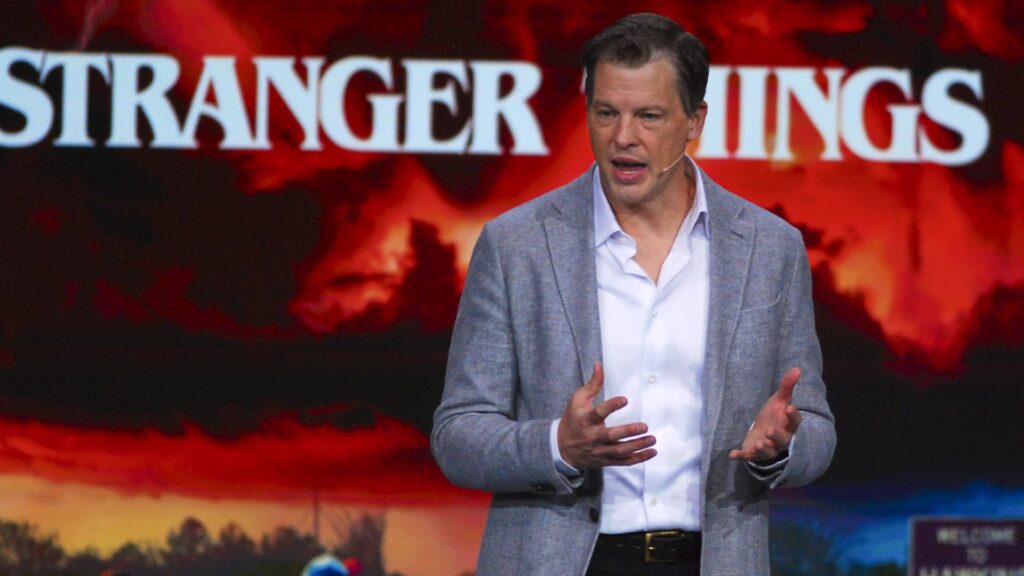
Netflix 2025 Financial Guidance Analysis: Strong Q1 Performance But Unchanged Full-Year Outlook Suggests Caution
Netflix 2025 Financial Guidance Analysis: Strong Q1 Performance But Unchanged Full-Year Outlook Suggests Caution
Table of Contents
- Netflix’s Q1 2025 Performance: Exceeding Expectations
- Analyzing Netflix’s 2025 Financial Guidance: Reading Between the Lines
- Economic Factors Influencing Netflix’s Conservative Outlook
- Streaming’s Historical Resilience During Economic Downturns
- The Strategic Shift: Moving Away from Subscriber Reporting
- Q2 2025 Projections and Revenue Outlook
- Market Implications and Investor Takeaways
Netflix’s Q1 2025 Performance: Exceeding Expectations
Netflix delivered an impressive first quarter in 2025, with financial results that exceeded both internal projections and Wall Street expectations. The streaming giant reported an operating margin of 31.7%, significantly outperforming analyst estimates of 28.5% according to StreetAccount data. This strong margin performance demonstrates Netflix’s continued focus on operational efficiency and profitability as key metrics for its business.
Key Q1 2025 Financial Metrics
- Operating Margin: 31.7% (vs. 28.5% analyst estimates)
- Revenue: $10.5 billion (in line with expectations)
- Q2 Operating Margin Guidance: 33.3% (vs. 30% analyst estimates)
- Q2 Revenue Guidance: $11 billion (slightly above expectations)
In their quarterly shareholder letter, Netflix executives specifically noted they were “ahead” of their own guidance for Q1 and are “tracking above the mid-point of our 2025 revenue guidance range.” This language suggests the company is performing better than it had initially projected at the beginning of the year, showcasing the strength of its current business model and content strategy.
However, despite this strong performance in Q1 and optimistic Q2 guidance, Netflix made a notable decision regarding its 2025 financial guidance that has raised questions among market analysts and investors.
Analyzing Netflix’s 2025 Financial Guidance: Reading Between the Lines
The most telling aspect of Netflix’s latest earnings report wasn’t what changed, but rather what didn’t. Despite exceeding expectations in Q1 and providing above-consensus guidance for Q2, Netflix declined to alter any of its longer-term 2025 financial guidance projections.
Reading the Signals
When a company outperforms in early quarters but maintains rather than raises full-year guidance, it often signals caution about later periods. In Netflix’s case, this suggests the company may be anticipating headwinds in the second half of 2025 that could offset the strong start to the year.
Netflix explicitly stated in its shareholder letter that “There’s been no material change to our overall business outlook since our last earnings report.” This flat statement, in the context of better-than-expected results, creates an interesting tension in the 2025 financial guidance narrative. While executives portrayed confidence during the earnings call, the unchanged full-year outlook suggests they’re preparing for potential challenges ahead.
This conservative approach to 2025 financial guidance is particularly noteworthy given Netflix’s historical pattern of raising guidance when performance exceeds expectations. The decision to maintain rather than boost guidance despite strong early results merits closer examination of the potential economic factors influencing this stance.
Economic Factors Influencing Netflix’s Conservative Outlook
Several macroeconomic factors may be contributing to Netflix’s cautious approach to its 2025 financial guidance. Most significantly, U.S. consumer sentiment is currently at its second-lowest level since 1952, according to data referenced in Netflix’s earnings discussion. This historical low in consumer confidence comes amid uncertainty related to President Donald Trump’s new tariff policies, which have created volatility in markets.
Economic Headwinds Facing Netflix
- Consumer sentiment: Near historic lows, potentially affecting discretionary spending
- Tariff policies: Creating market uncertainty and potential inflation pressures
- Subscription fatigue: Increasing competition for consumer entertainment dollars
- Global economic variations: Different recovery rates across Netflix’s international markets
- Currency fluctuations: Potential impact on international revenue when converted to USD
These economic headwinds create an environment where maintaining rather than raising 2025 financial guidance represents a prudent approach. Netflix executives may be concerned that even if the company’s business model has historically shown resilience during economic downturns, the current combination of factors presents unique challenges that could impact the second half of the year.
The streaming market has also become increasingly competitive since previous economic slowdowns, with consumers now having numerous subscription options competing for their entertainment budget. This raises questions about potential churn rates if economic conditions force households to prioritize their subscription services.
Streaming’s Historical Resilience During Economic Downturns
During the earnings call, Co-CEO Greg Peters addressed the potential impact of economic slowdowns on Netflix’s business, noting that the company has “been generally quite resilient” to such conditions in the past. This historical resilience forms a key part of Netflix’s narrative around its 2025 financial guidance.
The fundamental value proposition of streaming services like Netflix lies in their ability to provide a high volume of entertainment at a relatively low cost. With Netflix’s ad-supported tier priced at just $7.99 monthly, the service represents a cost-effective leisure option compared to alternatives like movie theaters, concerts, sporting events, or dining out.
Netflix’s Recession-Resistant Attributes
Several factors contribute to Netflix’s potential resilience during economic uncertainty:
- Low absolute cost relative to other entertainment options
- High perceived value with vast content library and regular new releases
- Flexible pricing tiers including ad-supported options
- At-home entertainment becoming more prioritized during economic constraints
- Content for multiple household members providing family-wide value
Peters’ comments specifically emphasized the stability Netflix is currently observing in key metrics: “Retention, that’s stable and strong. We haven’t seen anything significant in plan mix or plan take rate. Things generally look stable.” This statement suggests that despite broader economic concerns, Netflix isn’t currently seeing warning signs in its customer behavior data that would necessitate a change to its 2025 financial guidance.
However, the decision not to raise guidance despite outperformance indicates the company is taking a wait-and-see approach rather than assuming this stability will definitely continue through the year’s second half.
The Strategic Shift: Moving Away from Subscriber Reporting
A significant development in Netflix’s reporting practices adds another layer to the 2025 financial guidance analysis. Beginning with this quarter, Netflix has stopped reporting quarterly subscriber numbers, shifting its emphasis to revenue and profit metrics instead. This change in disclosure policy comes at an interesting moment given the potential economic challenges ahead.
Implications of Discontinuing Subscriber Reporting
Without quarterly subscriber metrics, investors will have less visibility into potential churn or slowdowns in customer acquisition. If economic conditions do impact Netflix’s business in the second half of 2025, the company will not be detailing subscriber fluctuations beyond the impact reflected in revenue and profit figures.
This reporting change aligns with Netflix’s broader strategy to focus investors on financial performance rather than subscriber growth as the company matures. However, in the context of unchanged 2025 financial guidance despite strong early results, the timing of this reporting change merits consideration.
The shift away from subscriber metrics also means that if Netflix does experience higher churn or slower growth due to economic pressures later in 2025, these trends would be less immediately apparent to investors and analysts. This could provide the company with some buffer against market reactions if consumer sentiment does begin to impact streaming subscription behaviors.
Q2 2025 Projections and Revenue Outlook
Looking ahead to the second quarter, Netflix provided revenue guidance of $11 billion, slightly above the analyst consensus. More significantly, the company projected a Q2 operating margin of 33.3%, substantially exceeding the 30% analyst expectation. These projections suggest Netflix anticipates continued strong performance in the near term.
| Metric | Q1 2025 Actual | Q2 2025 Guidance | Q2 Analyst Expectations |
|---|---|---|---|
| Revenue | $10.5 billion | $11 billion | Slightly below $11 billion |
| Operating Margin | 31.7% | 33.3% | 30% |
The projected sequential improvement in operating margin from Q1 to Q2 demonstrates Netflix’s confidence in continued operational efficiency and revenue growth in the immediate future. This positive short-term outlook makes the decision to maintain rather than raise full-year 2025 financial guidance all the more noteworthy.
The contrast between strong Q1-Q2 performance and unchanged full-year guidance suggests Netflix may be anticipating some combination of increased content costs, higher marketing expenses, or potential revenue challenges in the third and fourth quarters that would offset the first-half outperformance.
Market Implications and Investor Takeaways
For investors and market analysts, Netflix’s latest earnings report and 2025 financial guidance present a nuanced picture. The company is demonstrating strong operational execution and financial discipline, with margins exceeding expectations. However, the conservative approach to full-year guidance suggests prudent caution regarding the macroeconomic environment.
Key Takeaways for Investors
- Strong execution: Netflix is delivering operational excellence with margins exceeding expectations
- Pricing power: The company has successfully implemented price increases without significant customer resistance
- Ad-supported growth: The lower-priced tier provides additional resilience during economic uncertainty
- Cautious outlook: Unchanged full-year guidance despite strong Q1 suggests conservative planning
- Less transparency: The elimination of subscriber metrics reduces visibility into potential customer behavior changes
Netflix’s decision to maintain its 2025 financial guidance despite outperformance can be interpreted as a sign of responsible management preparing for potential headwinds. Rather than raising expectations based on early-year results, the company is taking a measured approach that provides flexibility if economic conditions deteriorate.
For the streaming industry as a whole, Netflix’s cautious outlook may be a leading indicator of how entertainment companies view the potential impact of economic uncertainty on their businesses. While home entertainment has historically shown resilience during downturns, the current subscription-heavy landscape represents a relatively untested model during serious economic contraction.
As 2025 progresses, investors will be watching closely for signs of how consumer sentiment impacts subscription behaviors across streaming platforms. Netflix’s performance in the second half of the year will serve as an important barometer for the sector’s resilience in challenging economic conditions.






